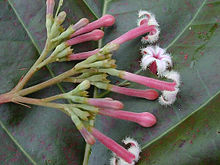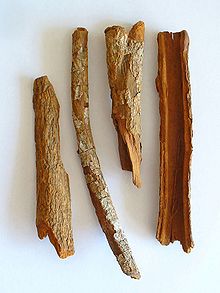Cinchona trees
| Cinchona trees | ||||||||||||
|---|---|---|---|---|---|---|---|---|---|---|---|---|

Cinchona calisaya , illustration |
||||||||||||
| Systematics | ||||||||||||
|
||||||||||||
| Scientific name | ||||||||||||
| Cinchona | ||||||||||||
| L. |
The plant genus Cinchona ( cinchona ) belongs to the family of the redness plants (Rubiaceae). The approximately 23 species are native to Central America ( Costa Rica , Panama ) and western South America ( Bolivia , Colombia , Ecuador , Peru , Venezuela , Brazil ). They thrive in the mountain regions. Some species and hybrids are grown in tropical areas around the world to obtain quinine, which is primarily known as a malaria drug .
description




Appearance and leaves
Cinchona species rarely grow as shrubs , mostly as trees . The bark is usually noticeably bitter.
In the flattened buds, the stipules are upright and pressed together. The leaves, which are arranged cross-opposite on the branches, are petiolate. The leaf blade is simple. There are mostly well-developed domatias on the leaves. The interpetiolaren or short fused to the branch Stipules are tongue-shaped to obovate and entire margin; they fall off.
Inflorescences and flowers
Terminally and often also in the leaf axils of the uppermost leaves are the zymous or panicle-shaped inflorescences , which contain many flowers and bracts , above an inflorescence stem .
The stalked, fragrant flowers are hermaphroditic, radial symmetry , five-fold with a double flower envelope . The five sepals are fused. The five yellow, pink, purple to red or sometimes white petals are fused together in the shape of a plate or funnel. The crown throat is hairy or bald on the inside and the corolla tube is often clearly five-ribbed on the outside. The five corolla lobes have densely ciliated to shaggy hairy edges. There is a circle with five fertile stamens ; they are inserted in the corolla tube and do not protrude above the corolla tube or at most slightly. The short to well-developed stamens are bare. Two carpels have become an under-earth, two-chambered ovary grown. In each ovary chamber there are many ovules in central angled placentation. The stylus ends in two branches of the stylus, each with a cephalic to linear scar.
Fruits and seeds
The egg-shaped to cylindrical or ellipsoidal capsule fruits are mostly septicidal and open with two valves from their base; sometimes the fruit capsules are loculicidal through a septum and then they open from the upper end. The stiff paper-like to woody capsule fruits often have lenticels , are surrounded by the durable calyx and contain many seeds. The medium-sized seeds are ellipsoidal to spindle-shaped and roughly flattened. The seeds have a membranous wing on the edge. The seeds contain a fleshy endosperm and the two cotyledons ( cotyledons ) are egg-shaped.
Origin of name
The name has nothing to do with China and probably comes from the Quechua word kina-kina (also quina-quina ) "bark of the bark" as a name for the bark of the red cinchona tree used as a medicine .
The botanical name Cinchona goes back to an allegedly successful healing of Countess Anna Condeza de Chinchón (1599-1640), wife of the Spanish viceroy of Peru , who fell ill with malaria in 1638 . She was cured by a drug that was administered to her by a Jesuit priest named Juan de Vega and personal physician of the viceroy, and which is said to have been processed into cinchona tree extract. For Carl von Linné this success story was the reason to give this plant genus the botanical name Cinchona in 1753.
In 1930, however, the diaries of this countess were discovered, which do not indicate that she ever suffered from malaria. Perhaps the success story should therefore be of assistance in marketing this remedy.
Spanish common names are Cascarilla, Costrona, Crespilla, Hoja de capulí, Hoja de lucma and Quina.
use
Bitter- tasting preparations can be made from cinchona bark (also called cinchonae cortex or fever bark) .
In 1808, Alexander von Humboldt named Quina as a name for cinchona bark , as well as Cascarilla fina de Loxa in his Views of Nature and mentioned the special quality of the bark of the tree species he called Cinchona Condaminea , which comes from the town of Loxa .
The cinchona tree originally comes from the mountainous regions of northern South America and is mainly cultivated in India and the Congo Basin . The bark of the cinchona bark tree ( Cinchona pubescens , also Cinchona officinalis ) was used earlier (since the 17th century) as a medicine against malaria and fever . The active ingredient in the bark , quinine , was first isolated in 1820 by Pierre Joseph Pelletier and Joseph Bienaimé Caventou . In addition to quinine, which is extracted industrially, it also contains quinidine and cinchonidine . However, not all species of the cinchona tree ( cinchona ) contain the active ingredient equally. Dutchman tried to Java Cinchona calisaya grow, while the English in India tried Cinchona succiruba to cultivate. In both species, however, it was found that their bark does not contain the active substance in sufficient quantities to justify extraction economically. Cinchona ledgeriana, on the other hand, has a rind that has an average of 13 percent quinine. After the failed attempt with Cinchona calisaya, it was grown in plantations by the Dutch on Java. (Note in the systematic section that the species described in this section are now synonyms.)
The quinine obtained from the bark was of great economic and medicinal importance until after the Second World War . The Kina office has watched over the control and promotion of cinchona bark production, the distribution of the quotas to the member states and the maintenance of price stability since 1922. Before the Second World War, 1500 tons of quinine were produced annually. During the Second World War, the destruction of cinchona tree plantations became a means of war. For example, the Japanese army felled 20,000 hectares of cinchona bark plantations on Java, so that the search for synthetically produced substitutes intensified. The similar effect, but associated with serious side effects Atebrin was by the German company in 1928 , IG Farben produced. Chloroquine and primaquine were the first synthetically produced active substances against malaria, which replaced the naturally produced quinine since the Second World War.
The red cinchona tree ( Cinchona pubescens ) is also used to obtain a medicine against digestive problems such as flatulence .
In addition, the extractable red dye can be used in its effect similar to the natural dye henna .
symbolism
The cinchona tree can be found on the coat of arms of Peru . The tree known there as quina , also taken from the Quechua language, is in a single field at the top heraldic left in the coat of arms and is supposed to symbolize the nature and flora of Peru.


Systematics and distribution
The genus Cinchona was established in 1753 by Carl von Linné in Species Plantarum , 1, p. 172. Type species is Cinchona officinalis L. Synonyms for Cinchona L. are: Kinkina Adanson , Quinquina Boehmer , Pleurocarpus Klotzsch .
The genus Cinchona belongs to the tribe Cinchoneae in the subfamily Cinchonoideae within the Rubiaceae family .
The approximately 23 species are originally distributed in Central America from Costa Rica to Panama and in western South America from Colombia and Venezuela via Bolivia , Ecuador to Peru .
There are about 24 (20 to 26) species in the genus Cinchona :
- Cinchona anderssonii Maldonado : The species first described in 2017 occurs in Bolivia.
- Cinchona antioquiae L. Andersson : The home is Colombia.
- Cinchona asperifolia Wedd. : It is distributed from Bolivian La Paz to southern Peru.
- Cinchona barbacoensis H. Karst. : It is widespread from western Colombia to the province of Carchi in Ecuador.
- Cinchona × boliviana Wedd. (Syn .: Cinchona × affinis Wedd. , Cinchona × erythroderma (Wedd.) Wedd. , Cinchona × pavoniana Kuntze , Cinchona micrantha var. Affinis (Wedd.) Wedd. Nom. Illeg., Cinchona micrantha var. Oblongifolia Wedd. , Cinchona ovata var. erythroderma Wedd. ): It is a hybrid of Cinchona calisaya × Cinchona pubescens ; It is widespread from Bolivia to Peru.
- Cinchona calisaya Wedd. ( Cinchona calisaya var. Ledgeriana Howard , Cinchona carabayensis Wedd. , Cinchona ledgeriana (Howard) Bern. Moens ex Trimen , Cinchona officinalis auct. Mult.): Home is Bolivia and Peru. It supplies the best-known of the yellow trade varieties of cinchona bark (king bark, most valuable = monopoly isaya from Bolivia). Plantations of Cinchona calisaya , known as Cinchona officinalis ,are often used.
- Cinchona capuli L.Andersson : The home is central and southern Ecuador.
- Cinchona fruticosa L.Andersson : It occurs only in the Peruvian Amazon region.
- Cinchona glandulifera Ruiz & Pav. (Syn .: Cinchona glandulosa Ruiz & Pav. Ex Triana , Cinchona undulata Pav. Ex Howard ): It occurs in east-central Peru.
- Cinchona hirsuta . Ruiz & Pav (Syn .: Cinchona pubescens var. Hirsuta (Ruiz & Pav.) TLC. , Cinchona tenuis Vell. , Cinchona tenuis Ruiz ex DC. ): It is common in Peru.
- Cinchona krauseana L. Andersson : It occurs only in the Peruvian Amazon region.
- Cinchona lancifolia Mutis : It is common in Ecuador, Colombia and western Venezuela.
- Cinchona lucumifolia Pav. Ex Lindl. : The home is Ecuador.
- Cinchona macrocalyx Pav. Ex DC. : The homeland is central Ecuador, western Bolivia and northern Peru.
- Cinchona micrantha Ruiz & Pav .: The home is eastern Peru.
- Cinchona mutisii Lamb. : The home is southern Ecuador.
- Cinchona nitida Ruiz & Pav. (Syn .: Cinchona discolor Klotzsch , Cinchona lancifolia var. Nitida (Ruiz & Pav.) Schult. , Cinchona peruviana var. Nitida (Ruiz & Pav.) Howard , Cinchona stenosiphon K. Krause ): She is coming only in the Peruvian region of Huánuco .
- Yellow cinchona bark tree ( Cinchona officinalis L. , Syn .: Cinchona angustifolia Ruiz nom. Illeg., Cinchona condaminea Humb. & Bonpl. , Cinchona legitima Ruiz ex Laubert , Cinchona lancifolia var. Lanceolata Schult. In JJRoemer & JASchultes , Cinchona cucumifolia Pav. Ex Lamb. , cinchona peruviana Mutis in JESmith , cinchona stupea Pav. ex Lamb. , cinchona academica Guibourt , cinchona chahuraguera Pav. ex DC. , cinchona condaminea var. chahuraguera DC. , cinchona macrocalyx var. obtusifolia DC. , cinchona macrocalyx var. uritusinga DC. , Cinchona obtusifolia Pav. Ex DC. , Cinchona uritusinga Pav. Ex DC. , Cinchona vritusino Pav. Ex DC. , Cinchona calisaya var. Josephiana Wedd. , Cinchona condaminea var. Vera Wedd. , Cinchona chahuraguera Pav. In JEHoward , Cinchona crispa Tafalla ex Howard , Cinchona palton Pav. In JEHoward , Cinchona subcordata Pav. Ex Howard , Cinchona suberosa Pav. In JEHoward , Cinchona uritusinga Pav. Ex Howard , Cinchona officinalis var. Bonplandianacolorata Howar d , Cinchona officinalis var. bonplandianalutea Howard , Cinchona officinalis var. condaminea (Humb. & Bonpl.) Howard , Cinchona officinalis var. Crispa (Tafalla ex Howard) Howard , Cinchona officinalis var. Uritusinga (Pav. Ex Howard) Howard , Cinchona josephiana (Wedd.) Wedd. , Cinchona lucumifolia var. Stupea Wedd. , Quinquina palton (Pav.) Kuntze , Cinchona officinalis var. Josephiana (Wedd.) Cárdenas , Cinchona officinalis var. Vera Cárdenas ): The homeland is southern Ecuador.
- Cinchona parabolica Pav .: It is common from southeast Ecuador to northern Peru.
- Cinchona pitayensis (Wedd.) Wedd. : It is common from central Ecuador to southern Colombia.
- Red cinchona bark tree ( Cinchona pubescens Vahl , Syn .: Cinchona succirubra Pav. Ex Klotzsch ): The distribution area extends from Costa Rica to western South America.
- Cinchona pyrifolia L.Andersson : It occurs only in the Peruvian region of Huánuco .
- Cinchona rugosa Pav .: The homeland is southeast Ecuador.
- Cinchona scrobiculata Humb. & Bonpl. : It occurs only in the Peruvian region of Cajamarca .
- Cinchona villosa Pav. Ex Lindl. : It is common from southeast Ecuador to northern Peru.
literature
- Tao Chen & Charlotte M. Taylor: Cinchona . Rubiaceae. In: Flora of China Editorial Committee: Wu Zheng-yi, Peter H. Raven & Deyuan Hong (Eds.): Flora of China . Cucurbitaceae through Valerianaceae, with Annonaceae and Berberidaceae. Volume 19. Science Press and Missouri Botanical Garden Press, Beijing and St. Louis 2011, ISBN 978-1-935641-04-9 , pp. 88–89 (English, “ Cinchona - Online ” - online text is identical to the printed work; full text online). (Section description, distribution and systematics).
- Lennart Andersson: A revision of the genus Cinchona (Rubiaceae-Cinchoneae). In: Memoirs of the New York Botanical Garden. Volume 80, 1997, pp. 1-75.
- Wolf-Dieter Müller-Jahncke : cinchona bark. In: Werner E. Gerabek , Bernhard D. Haage, Gundolf Keil , Wolfgang Wegner (eds.): Enzyklopädie Medizingeschichte. De Gruyter, Berlin / New York 2005, ISBN 3-11-015714-4 , p. 243.
Web links
Individual evidence
- ↑ a b Cinchona in Trees and shrubs of the Andes of Ecuador at eFlora. (span.)
- ^ Brockhaus encyclopedia. 24 volumes. 19th edition. Mannheim 1987, Volume 4, p. 486.
- ↑ Müller-Jahncke: cinchona bark. 2005.
- ↑ Jean Marie Pelt: The secrets of medicinal plants. Verlag Knesebeck, Munich 2005, ISBN 3-89660-291-8 , p. 55.
- ↑ Jean Marie Pelt: The secrets of medicinal plants. Verlag Knesebeck, Munich 2005, ISBN 3-89660-291-8 , p. 70.
- ↑ First publication scanned at biodiversitylibrary.org .
- ↑ a b Cinchona in the Germplasm Resources Information Network (GRIN), USDA , ARS , National Genetic Resources Program. National Germplasm Resources Laboratory, Beltsville, Maryland. Retrieved October 18, 2017.
- ↑ Cinchona at Tropicos.org. Missouri Botanical Garden, St. Louis
- ↑ a b c d e f g h i j k l m n o p q r s t u v w x y z Rafaël Govaerts (Ed.): Cinchona. In: World Checklist of Selected Plant Families (WCSP) - The Board of Trustees of the Royal Botanic Gardens, Kew . Retrieved November 2, 2018.




